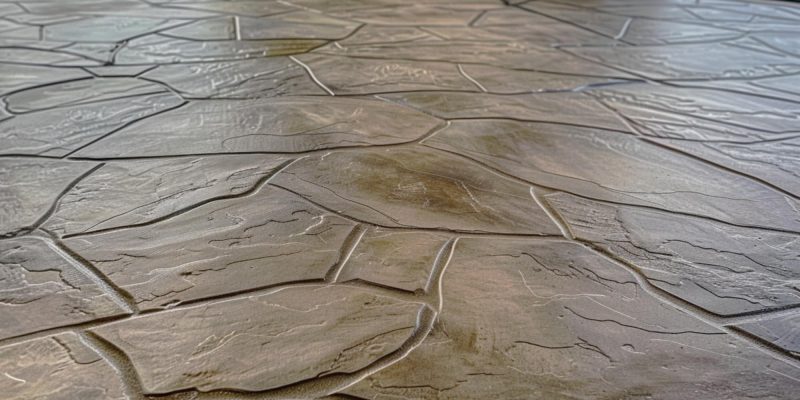Welcome to the world of stamped concrete, a fantastic choice for anyone looking to spruce up their home’s outdoor or indoor spaces. In this blog, we’ll dive into what stamped concrete is, how it’s different from other concrete finishes, and explore its many benefits and uses. Ready to transform your space? Let’s get started!
What is Stamped Concrete?
Stamped concrete is a special way to make your concrete floors or pathways look like they’re made from stone, brick, or other fancy materials. It’s done by pressing molds into the concrete before it dries. This method is great because it lets you have beautiful, unique designs without spending a lot of money.
How is it different?
Stamped concrete, unlike plain concrete (a simple mix of water, cement, and aggregate), adds a creative twist by imprinting patterns and textures onto the surface before it fully dries.
Here’s how it compares to other popular concrete finishes:
Plain Concrete
The most basic form of concrete finish, plain concrete, is known for its durability and versatility but lacks the aesthetic appeal of stamped concrete. It’s often used for sidewalks, driveways, and indoor spaces where decoration isn’t a priority.
Polished Concrete
This finish involves grinding down the surface of hardened concrete to achieve a smooth, shiny appearance. While polished concrete is popular for its modern look and low maintenance, it doesn’t offer the same range of patterns and textures as stamped concrete.
Exposed Aggregate
Achieved by removing the top layer of concrete to reveal the aggregate (stones, sand, and pebbles) beneath, exposed aggregate provides a textured finish with a natural look. However, it lacks the ability to mimic other materials like stamped concrete can.
Stenciled Concrete
Similar to stamped concrete, stenciled concrete uses disposable paper stencils to create patterns on the concrete surface. While it allows for intricate designs, it doesn’t provide the same three-dimensional texture that stamped concrete does.
Acid-Stained Concrete
This finish involves applying an acid-based stain to the concrete to achieve vibrant colors and patterns. While acid staining can produce unique, variegated finishes, it’s primarily color-focused and doesn’t offer the texture and pattern variety of stamped concrete.
Stamped concrete differs in its ability to closely mimic the look and texture of more expensive materials…
Stamped concrete differs in its ability to closely mimic the look and texture of more expensive materials like stone, brick, and wood, offering homeowners a cost-effective way to add beauty and value to their properties. With a wide range of patterns and colors available, stamped concrete provides unmatched versatility and design options for both indoor and outdoor applications.
The Distinctive Appeal of Stamped Concrete
Stamped concrete is not just about saving money; it’s also about making your home look amazing. You can choose from lots of different patterns and colors to match your home’s style. Whether you want a patio that looks like it’s made of old bricks or a driveway with a fancy stone pattern, stamped concrete makes it possible.
Applications of Stamped Concrete
Stamped concrete is super versatile. Here are a few ways you can use it:
Outdoor Applications
- Patios and Walkways: Make your backyard a cozy gathering spot or a beautiful garden path.
- Driveways and Pool Decks: Boost your curb appeal with a driveway that shines or a pool deck that feels like a luxury resort.
Indoor Applications
- Flooring Solutions: Yes, you can use stamped concrete inside, too! It’s perfect for basements or other rooms where you want a durable, easy-to-clean floor with a unique look.
Advantages of Stamped Concrete
Choosing stamped concrete comes with a bunch of perks. Here’s why it’s a smart choice:
- Cost-Effective: Get the look of expensive materials without emptying your wallet.
- Durable and Long-Lasting: Stamped concrete is tough and can handle lots of foot traffic, making it perfect for both indoor and outdoor use.
- Low Maintenance: Unlike real stone or wood, stamped concrete is easy to take care of. A simple reseal every few years keeps it looking fresh.
- Aesthetic Value: Not only does stamped concrete look great, but it can also increase your home’s value because of its high-end appearance.
Exploring Patterns and Colors
When it comes to stamped concrete, the variety of patterns and colors available allows homeowners to tailor their spaces to match any design aesthetic. Here are some common patterns and popular colors in stamped concrete:
Common Patterns
- Stone Patterns: Mimic natural stone surfaces such as slate, flagstone, or fieldstone, offering a rustic or elegant outdoor look.
- Brick Patterns: Recreate the appearance of traditional brick, perfect for pathways, patios, or driveways seeking a classic style.
- Wood Patterns: Imitate the look and texture of wooden planks or logs, ideal for creating a warm, inviting space with the durability of concrete.
- Cobblestone: Capture the old-world charm of cobblestone streets, suitable for historic home styles or romantic garden paths.
- Tile Patterns: Emulate the clean lines of ceramic or stone tiles, a good choice for modern homes and sleek outdoor living areas.
Popular Colors
- Earthy Tones: Browns, tans, and terracottas blend seamlessly with natural landscapes, making them a popular choice for outdoor areas.
- Grays and Charcoals: Offer a modern, sophisticated look, perfect for contemporary designs and urban settings.
- Beiges and Creams: Provide a soft, neutral backdrop that complements any home color scheme, enhancing the overall aesthetic without overwhelming.
- Accent Colors: Blue, red, or green can be used as accent colors to highlight specific areas or features, adding depth and interest to the design.
RECOMMENDATION
Create a custom look that reflects your personal style while enhancing the functionality and appeal of your space by selecting specific patterns and colors.
Types of Stampers and Tools
Creating beautiful stamped concrete is an art that requires specific tools and stampers. Here’s a closer look at the types of stampers and tools used in the process:
Rigid vs. Flexible Stampers
Rigid Stampers: Made of heavy-duty polyurethane, rigid stampers are ideal for stamping large, flat areas where uniform depth and texture are desired. Their sturdiness helps to ensure consistent patterns across the surface.
Flexible Stampers: These are thinner and more pliable than rigid stampers, making them perfect for getting into edges, corners, and curved areas where rigid stampers can’t reach. Flexible stampers help to complete the look without leaving any areas untouched.
Specialty Tools
Texturing Skins: Unlike stampers that imprint specific patterns, texturing skins are used to add general texture to the concrete surface. They can mimic natural stone textures or add a unique finish that complements the main pattern.
Rollers: Designed to apply texture across a wide area quickly, rollers are often used for adding finer details or for touching up after the main stamping process. They can simulate smaller patterns like brick borders or cobblestone edges.
Tamper: A tamper is used to press the stampers into the concrete firmly and evenly. This ensures that the pattern is clearly imprinted into the surface without any missed spots.
Using the right combination of stampers and tools is crucial for achieving the desired look and feel of stamped concrete. Professionals carefully select their tools based on the project’s specific requirements, ensuring that every detail is perfectly executed.
Common Issues and FAQs about Stamped Concrete
How Do I Keep My Stamped Concrete Looking New?
Keeping your stamped concrete looking great is easy! Clean it regularly with a broom or hose and reseal it every 2-3 years. Resealing protects the color and texture from fading and wear.
Can Stamped Concrete Crack?
Like all concrete, stamped concrete might crack over time. However, professionals can add “control joints” to help prevent this. These are planned cracks that are hardly noticeable and keep other cracks from appearing in visible areas.
How Long Does Stamped Concrete Last?
Stamped concrete is very durable. With proper care, it can last for decades. The key is to reseal it as recommended and clean up spills quickly to avoid stains.
What Affects the Cost of Stamped Concrete?
The cost depends on the complexity of your design, the size of the area, and your location. Basic patterns are more affordable, while intricate designs with multiple colors and patterns will cost more. Getting a quote from a local contractor is the best way to understand the specific costs of your project.
Is Stamped Concrete Slippery?
When wet, stamped concrete can be slippery, especially if it’s sealed. To make it safer, ask for a non-slip additive to be mixed into the sealant. This gives the surface a bit more grip, reducing the risk of slips and falls.
Conclusion
Stamped concrete is an excellent choice for anyone looking to enhance the look of their home without breaking the bank. It’s durable, low maintenance, and can mimic a wide range of materials, making it perfect for various applications. Whether you’re upgrading your patio, driveway, or even your indoor floors, stamped concrete offers a beautiful, cost-effective solution. Remember, the key to long-lasting beauty is proper care and maintenance. So why not consider stamped concrete for your next home improvement project? It could be the perfect way to add a touch of elegance and practicality to your space.

